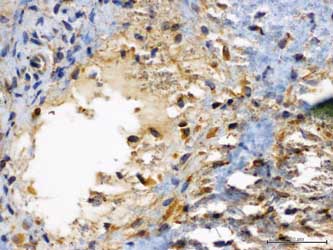The use of grafting material biphasic calcium sulfate for the treatment of osseous defects resulting from radicular cysts. Clinical study and six-month follow up

All claims expressed in this article are solely those of the authors and do not necessarily represent those of their affiliated organizations, or those of the publisher, the editors and the reviewers. Any product that may be evaluated in this article or claim that may be made by its manufacturer is not guaranteed or endorsed by the publisher.
Aim Surgical treatment of odontogenic cysts of the jaws accounts for a significant percentage of dental surgery procedures. Additionally, a wide range of procedures and augmentation materials are used in the reconstruction of these osseous defects. The authors present a study including histology of surgical treatment of odontogenic cysts using a biphasic calcium sulfate composite bone graft.
Materials and methods Two groups, study and control, of 30 patients each with odontogenic cyst were treated for radicular cyst removal with reconstructive surgery using a deproteinized bovine bone graft (xenograft). A modified surgical procedure was performed in the control group, with different types of graft placed in the osseous defects. In the study group wound site closure was performed without periosteum cutting to allow stretching of the flap to attempt primary site closure, whereas in the control group primary wound closure was achieved to protect the xenograft material.
Results In the study group complete wound healing and suture maintenance was reported in 29 patients (96.6%); in 1 case (3.4%), a postoperative wound dehiscence (I°) occurred on day 5. In the control group no wounds dehiscences were observed in 24 patients (80%), in 4 cases (12%) a wound dehiscence (I°) occurred on day 3 and 5 and in 2 cases (8%), IIº wound dehiscence over 10 mm with secondary inflammatory features were observed which required graft removal.
Conclusions The use of the Bond Apatite® preparation proved to be a simple, inexpensive and effective reconstructive treatment of osseous defects after enucleation of odontogenic cysts.
Copyright (c) 2020 Ariesdue Srl

This work is licensed under a Creative Commons Attribution-NonCommercial 4.0 International License.
The Journal of Osseointegration has chosen to apply the Creative Commons Attribution NonCommercial 4.0 International License (CC BY-NC 4.0) to all manuscripts to be published.


 https://doi.org/10.23805/JO.2020.12.02.18
https://doi.org/10.23805/JO.2020.12.02.18







